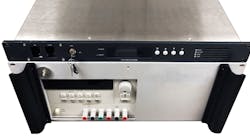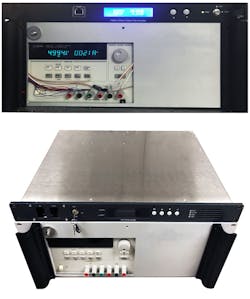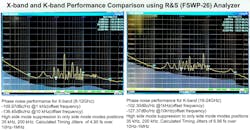Download this article in PDF format.
Reducing noise in higher-frequency oscillators is one way to achieve reliable, high-data-rate communications, although noise tends to rise with increasing frequency. All sorts of oscillators and frequency-synthesis techniques have been applied in recent years in attempts to trim phase-noise levels at microwave frequencies. Many of these approaches have been electrical in nature.
Taking a different tack, Synergy Microwave Corp. and Drexel University jointly developed a line of frequency synthesizers that leverage optical circuit techniques to help achieve lower-noise microwave signals at X- and K-band frequencies. In these low-noise frequency synthesizers, optoelectronic transmission lines and optoelectronic oscillators (OEOs) are part of the solution for reducing both close-in and far-from-the-carrier phase noise in microwave signal sources.
The latest line of low-noise frequency synthesizers from Synergy Microwave Corp. (Fig. 1) builds upon OEOs to produce tunable, low-noise output signals at X- and K-band frequencies. They use long fiber-optic delay lines to reduce phase noise close to the carrier. The synthesizers also employ self-phase-locked-loop (SPLL) and self-injection-locking (SIL) techniques to reduce phase noise otherwise located close-in and far-from the carrier, respectively.
1. Shown in two views, this line of rack-mountable frequency synthesizers employs different techniques and technologies to trim phase noise at X- and K-band frequencies.
The X- and K-band frequency synthesizers are truly subsystem designs, incorporating several different technologies to provide variable-frequency output signals with low phase noise. The frequency synthesizers are suitable for applications in test systems, wireless-communications systems, radar systems, and remote-sensing systems, or wherever microwave receivers require high sensitivity not limited by phase noise.
The frequency synthesizers orchestrate SIL and double-sideband PLL techniques simultaneously, with multiple signal paths within the synthesizers in support of enhanced signal stability as well as application of modulation as needed. Signals are combined within the synthesizer with the aid of a custom-designed, double-balanced frequency mixer and lowpass-filter-amplifier (LPFA) assembly. The synthesizer design also incorporates operational-amplifier (op-amp) circuits that work as the phase detector and lowpass portion of the PLL.
Very Much in Tune
The high resolution and wavelength-sensitive tuning is due to the fine tuning made possible by an optical transversal filter. The optical filter uses a chirped fiber Bragg grating (CFBG) as a dispersive component to achieve narrowband filtering. A current-tuned YIG filter is used in cascade along with the optical filter and CFBG to provide coarse frequency tuning across wide tuning ranges of X- and K-band frequencies.
At X-band frequencies from 9 to 11 GHz, for example, the YIG filter tunes with a response of about 25 MHz/mA. Since the resolution of the current supply feeding the YIG filter is about 1 mA, the effective frequency-tuning resolution of the YIG filter is 25 MHz. This combination of optical and electronic technologies results in relatively wide frequency-tuning ranges with outstanding phase noise, both close in and far from the carrier.
Case in point: at X-band, the single-sideband phase noise is −109.97 dBc/Hz offset 1 kHz from the carrier and −136.45 dBc/Hz offset 10 kHz from the carrier for carrier frequencies from 9 to 11 GHz (Fig. 2). In the time domain, this translates to 4.395 fs measured at sidemode markers of 35 and 200 kHz from the carrier. At higher K-band frequencies, the SSB phase noise is −102.30 dBc/Hz offset 1 kHz from the carrier and −127.37 dBc/Hz offset 10 kHz from the carrier, or time-domain response of 6.961 fs measured at sidemode markers of 35 and 200 kHz from the carrier.
2. The low phase noise at X-band frequencies is evident both close to and far from the carrier.
In terms of size and power, the YIG filter is the dominant component in these optoelectronically driven frequency synthesizers. The synthesized signal source can be contained in a 19-in. rack-mount enclosure for portability.
The main current consumption in the frequency synthesizer assembly takes place due to the YIG filter, which draws 150 mA at +10 V dc and about 1.5 W power. The amplifier, with two channels, draws 80 to 160 mA currents at +10 V dc and as much as 1.6 W power. The mixer LPFA, which uses a combination of frequency translation and filtering to extract the RF/microwave signals from higher-frequency optical signals, draws about 60 + 5 + 45 mA, or 110 mA current, from respective supplies of +15, +5, and −5 V dc.
In stark contrast, the photodetector used in the frequency synthesizer operates at very low current and power, with its three cells each drawing about 10 mA current or 30 mA current at +5 V dc and about 0.15 W power as part of the frequency synthesizer dominated in terms of size and power by the YIG filter. The broadband dual-channel amplifier draws roughly 80 mA current per channel or 160 mA current from a +10-V dc supply, or about 1.6 W total power as part of the frequency synthesizer.
Synergy Microwave Corp., 201 McLean Blvd., Paterson, NJ 07504; (973) 881-8800, FAX: (973) 881-8361, e-mail: [email protected].
Bibliography
U. L. Rohde, A. Poddar, and A. Daryoush, “Self-injection locked phase locked loop optoelectronic oscillator,” U.S. Patent No. US9088369B2, 2012.
U. L. Rohde, A. Poddar, and A. Daryoush, “Integrated production of self-injection locked self-phase locked opto-electronic oscillators,” U.S. Patent No. US9094133B2, 2013.
T. Sun, L. Zhang, A. K. Poddar, U. L. Rohde, and A. S. Daryoush, “Frequency synthesis of forced opto-electronic oscillators at the X-band,” Chinese Optical Letters, Vol. 15, 010009 (2017).
L. Zhang, A. K. Poddar, U. L. Rohde and A. S. Daryoush, “Self-ILPLL Using Optical Feedback for Phase Noise Reduction in Microwave Oscillators,” IEEE Photonics Technology Letters, Vol. 27, No. 6, March 15, 2015, pp. 624-627.
L. Zhang, A. Poddar, U. Rohde, and A. S. Daryoush, “Phase noise reduction and spurious suppression in oscillators utilizing self-injection loops,” 2014 IEEE Radio and Wireless Symposium (RWS), Newport Beach, CA, 2014, pp. 187-189.
L. Zhang, A. K. Poddar, U. L. Rohde, and A. S. Daryoush, “Comparison of Optical Self-Phase Locked Loop Techniques for Frequency Stabilization of Oscillators,” IEEE Photonics Journal, Vol. 6, No. 5, October 2014, pp. 1-15.
T. Sun, L. Zhang, A. K. Poddar, U. L. Rohde, and A. S. Daryoush, “Forced SILPLL oscillation of X- and K-band frequency synthesized opto-electronic oscillators,” 2016 IEEE International Topical Meeting on Microwave Photonics (MWP), Long Beach, CA, 2016, pp. 91-94.
L. Zhang, A. Poddar, U. Rohde, and A. Daryoush, “Analytical and Experimental Evaluation of SSB Phase Noise Reduction in Self-Injection Locked Oscillators Using Optical Delay Loops,” IEEE Photonics Journal, Vol. 5, No. 6, December 2013, pp. 6602217-6602217.



